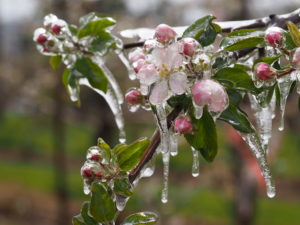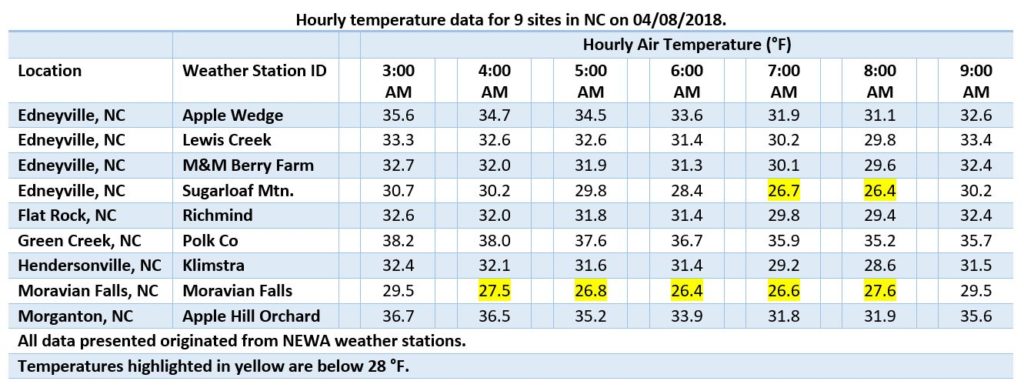Apple Horticultural Update: Cold Temperatures and Crop Load Management
go.ncsu.edu/readext?520557
en Español / em Português
El inglés es el idioma de control de esta página. En la medida en que haya algún conflicto entre la traducción al inglés y la traducción, el inglés prevalece.
Al hacer clic en el enlace de traducción se activa un servicio de traducción gratuito para convertir la página al español. Al igual que con cualquier traducción por Internet, la conversión no es sensible al contexto y puede que no traduzca el texto en su significado original. NC State Extension no garantiza la exactitud del texto traducido. Por favor, tenga en cuenta que algunas aplicaciones y/o servicios pueden no funcionar como se espera cuando se traducen.
Português
Inglês é o idioma de controle desta página. Na medida que haja algum conflito entre o texto original em Inglês e a tradução, o Inglês prevalece.
Ao clicar no link de tradução, um serviço gratuito de tradução será ativado para converter a página para o Português. Como em qualquer tradução pela internet, a conversão não é sensivel ao contexto e pode não ocorrer a tradução para o significado orginal. O serviço de Extensão da Carolina do Norte (NC State Extension) não garante a exatidão do texto traduzido. Por favor, observe que algumas funções ou serviços podem não funcionar como esperado após a tradução.
English
English is the controlling language of this page. To the extent there is any conflict between the English text and the translation, English controls.
Clicking on the translation link activates a free translation service to convert the page to Spanish. As with any Internet translation, the conversion is not context-sensitive and may not translate the text to its original meaning. NC State Extension does not guarantee the accuracy of the translated text. Please note that some applications and/or services may not function as expected when translated.
Collapse ▲A cold front passed through the southeast over the weekend, resulting in temperatures near or below critical temperatures for apple. For your reference, Michigan State University complied an illustrated reference with critical temperatures of major tree fruit crops (research done by Washington State University). A table summarizing cold temperatures observed in several NC apple growing sites is below (click table to enlarge). Based on weather station data, sites in Georgia and South Carolina did not get below freezing on 04/08/18 and are not presented.
In general, most apple varieties are at a stage of bud development between tight cluster and bloom, and some sites observed temperatures that could result in damage. The aforementioned critical temperatures only serve as a guide, your specific site/situation needs to be considered. Several factors determine the potential severity of blossom mortality, including site, location, bud development stage at time of freeze event, lowest temperature observed, the duration of low temperature exposure, cultivar, cropping history, and tree health.
The presence and severity of frost/freeze damage can be estimated by dissecting flower buds and assessing viability. Researchers at Penn State University developed a method for assessing fruit bud survival.
While this activity is labor-intensive (especially if conducted across multiple blocks and/or varieties), obtaining an estimate of bud damage is of tremendous value in future crop load management decisions. As an example, a grower may be very reluctant to apply a carbaryl (Sevin) at petal fall with concerns about frost/freeze damage. However, if an estimate of frost damage suggested that some damage was observed but there are still enough viable flowers to set 600% of a full crop, a petal fall thinner would be a very attractive option. Conversely, if excessive damage is observed, then thinning should not be considered until fruit set and active fruit growth is observed. During an early and cool spring, it is easy to forget that only 2 to 12 % viable blossoms are required to set a commercial crop of apples. We plan to estimate the extent of injury at sites where low temperatures were observed.
Thinning Update
While there are certainly exceptions, most varieties have a moderate to heavy bloom density. We’ve observed a protracted bloom period, due to relatively cool temperatures. Pollinator activity has been somewhat limited, but I do not anticipate negative consequences on initial fruit set. Conditions appear to improve during the mid to latter part of the week, as a warm air mass will move into the region.
We plan to provide updates regarding crop load management decisions over the next several weeks. For those using the carbon balance model to help inform thinning decisions, remember to keep track of full bloom dates and have your green tip date on-hand.
Amid-Thin® W
On a final note, I presented some information at the winter meetings regarding a “new” thinner that was recently registered in North Carolina. Amid-Thin® W is now registered in North Carolina, South Carolina, and Georgia.
While recently re-registered, Amid-Thin® W (naphthaleneacetamide; NAD) is an old thinner that was recognized to have thinning activity in the late 1930’s. NAD is the amide salt of naphthaleneacetacetic acid (NAA; Fruitone L®; PoMaxaTM; RefineTM, etc.). When compared to NAA, NAD is a relatively mild thinner but has activity over a longer period. NAD is recommended for use as an early thinner at late bloom or petal fall. In recent years, there is renewed interest in the use of this product as an early thinner in eastern crop load management programs.
Recent research from the northeast and mid-Atlantic suggests:
- Since it is a weak thinner, this product is most effective on easy-to-thin or moderately difficult-to-thin varieties.
- Where appropriate, rates of 40 to 50 ppm should be utilized at late bloom to petal fall.
- NAD can increase the formation of pygmy fruit and should not be used on varieties prone to pygmy fruit development, such as ‘Red Delicious’ or ‘Fuji’.
- Do not apply during post-bloom (7 to 16 mm) or rescue thinning (18 to 24 mm )windows.
There is limited data available regarding this NAD’s utility in the southeastern thinning programs. We plan to evaluate this product in 2018.




